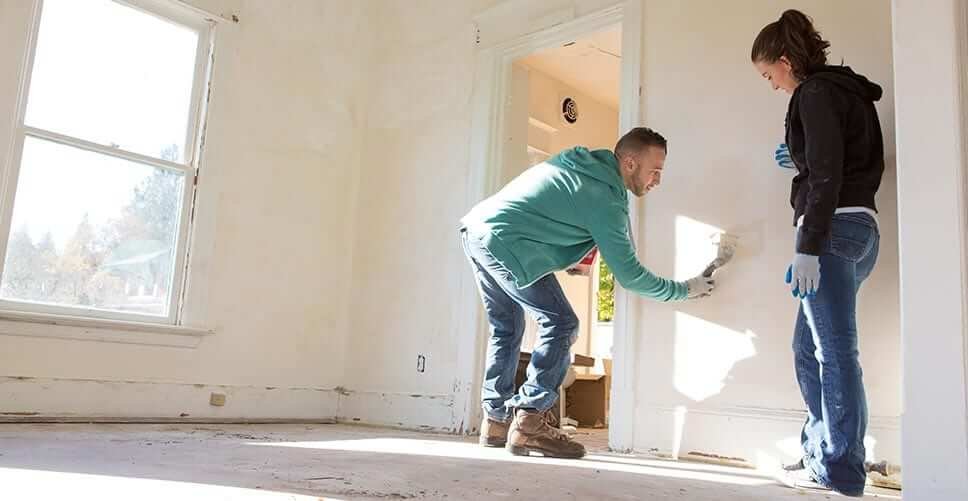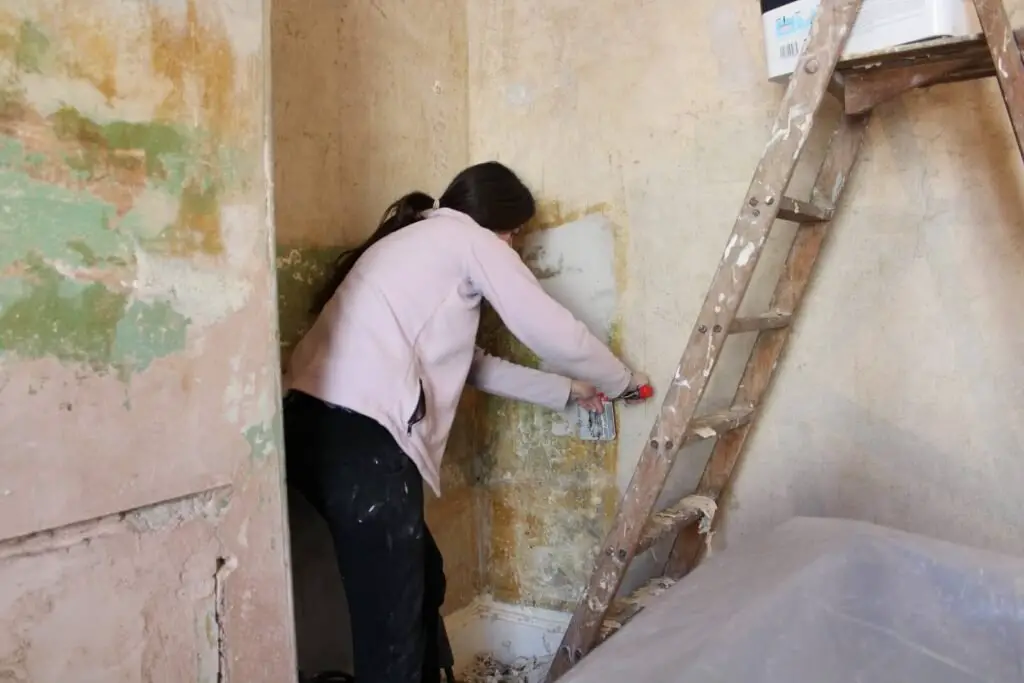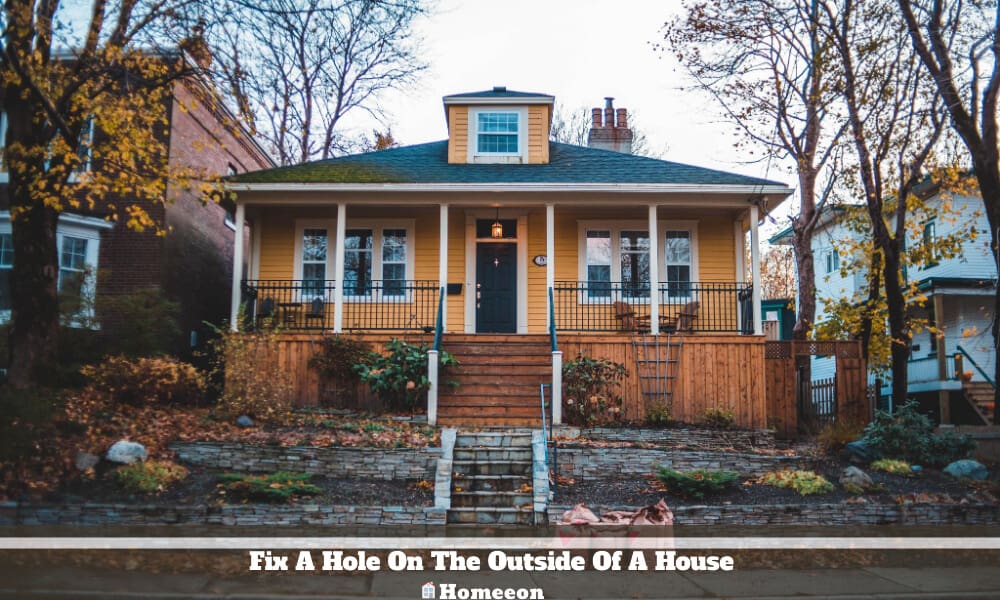Last Updated on August 3, 2023 By Emma W. Thomas
To fix a hole in the outside of a house:
- Clean the area
- Apply a patch or filler suitable for the surface (e.g., caulk, putty, or stucco)
- Smoothen the surface
- Finally, paint or finish to match the surrounding area for a seamless repair
Various Methods Of Fixing A Hole

Drywalls may be durable but not indestructible. During tenure, homeowners end up with at least one or more unwanted holes in the house’s interior or exterior. There are so many ways of repairing such holes. Some of the methods include:
Using Toothpaste To Fix The Hole
Toothpaste is used when a small nail hole is involved. The process is as simple as squeezing in some white toothpaste gel into the hole. Smoothen with a knife or any flat item available, and the process is done. Dry toothpaste forms a sparkling finish similar to the wall and may go unnoticed sometimes.
If white toothpaste is not available, you could use bar soap as an alternative. It involves dampening the surface of the soap and rubbing it over a shallow hole until it is filled. Avoid blue toothpaste as it does not work the same as white toothpaste.
Using A Homemade Sealant
This method involves creating a stronger sealant than toothpaste and soap since it is more effective and durable. The adhesive is made by adding baking soda to superglue, forming a super-strong bond. The amount to be created depends on the size of the hole to be sealed. A small nail hole will require a few drops of super glue and a pinch of baking soda.
Before application, wear protective rubber gloves to avoid the fast drying and strong sealant from coming into contact with your hands. Apply the mixture immediately to the wall as it is fast-drying. After the glue has dried, sand the hard plastic-like finish until it flushes with the main wall. This method is not only effective for small holes but also for minor cracks in the wall too. The use of superglue makes it long-lasting and very effective.
Using Flour To Fix The Hole
This method applies to holes of doorknob sizes with diameters of two to four inches. It involves making a simple patch using simple kitchen items and recycled cardboard. To create a patch and fix the hole, you can follow these steps:
- Cut a small sizeable cardboard that is larger than the size of the hole one is intending to fix.
- Make two holes at the center of the cut-out piece of cardboard. Thread a short string through one of the spots and come out through the other.
- Push the cardboard into the hole, with the strings facing away from the wall. One should ensure all corners of the cardboard are intact with the wall.
- Ensure the cardboard is intact by pulling the strings tightly.
- Form a flour paste by mixing one tablespoon of flour with one tablespoon of salt and some water.
- Apply the mixture to the cardboard on the wall with some oozing outside the square. It will ensure all edges of the cardboard are bound to the wall.
- After the paste has settled and dried, one can pull out the string.
- Finally, apply a second coat of the paste and smoothen it and ensure that it flushes with the surrounding wall to give a finished look.
How Can You Cover Large Holes And Openings Outside Your House?
There are two significant ways to fill large gaps and holes outside the house.
Using Steel Wool And Foam For Holes And Gaps Around Pipes
You can fill the holes with steel wool and copper mesh to create a base layer. Later on, use expandable polyurethane foam to fill the gaps. After the polyurethane foam has cured, you can trim it to flush it with the house. Some people prefer to strain and paint the patch to match with the walls. This method is effective since gnawing rodents cannot pass through the mesh even if they chewed and scratched the foam.
Use Of A Fine Mesh
You can use a fine mesh to cover holes and vents that cannot be closed completely, such as chimneys and attic vents. Since these areas cannot be covered entirely, a barrier to their entrance needs to be created. One can cover these openings with fine wire mesh that prevents large animals such as raccoons and squirrels from entering the house while still serving their purpose.
How to Fix a Medium-size Hole
Repairing a medium-sized hole in your wall may seem like a daunting task, but with the right steps and tools, it can be a straightforward and satisfying DIY project. Here’s a step-by-step guide on how to fix a medium-sized hole.
1. Gather the Necessary Tools
Before delving into the project, you’ll need to assemble a few indispensable tools. They are:
- Knife
- Sandpaper
- Drywall compound
- Drywall or patch kit
- Taping knife
- Paint
2. Prepare the Damaged Area
With a utility knife, carefully cut the damaged section smoothly. Make sure the pointed edges and loose debris get eliminated to create a clean square or rectangle.
3. Cut the Patch Material
If you’re using a drywall patch, trim it so that it carefully fits the hole. For larger holes, a piece of drywall will do the job. Cut the drywall to a size slightly bigger than the hole.
| Tools | Purpose | ||
| Utility Knife | Cut out damaged section | ||
| Drywall | Patch material for the hole | ||
| Tape Measure | To measure hole and patch size |
4. Apply the Patch
Insert the drywall or patch to cover the hole and make sure it fits securely. Use a fast-drying adhesive on the back to hold it in place if needed.
5. Seal the Edges
You’ll need to use a sealer or primer around the edges of the hole. This will help blend in the patch.
6. Apply Joint Compound
Next, apply a thin layer of joint compound over the drywall tape or patched hole using a taping knife. It is advised to extend the compound beyond the hole edges for smoother blending.
7. Sand and Smooth
Once the compound is completely dry, use sandpaper to smooth over the area. The wall surface should be flat and consistent.
8. Final Touches
After waiting for it to dry thoroughly, it’s time to either apply the finishing coat or the primer and then paint a matching color.
How to Fill a Small Hole
From an unattractive dent on a wall to a small peephole on a wooden door, small holes can be unsettling and blemish the aesthetics of living space. Repairing a small hole can be an easy task if the correct method is applied. Here’s a listicle detailing step by step how to fill a small hole.
Step 1: Gather the Necessary Tools
The first step in repairing a small hole is preparing the tools and materials you’ll need. This might include a:
- Putty knife
- Sandpaper
- Wall filler or plaster
- Primer
- Paint
Step 2: Clean the Area
Thoroughly clean the area around the hole to remove any loose dirt or debris. This is critical because it ensures the compound adheres to the wall effectively.
Step 3: Apply the Filler or Plaster
Apply the filler or plaster into the hole using a putty knife. Make sure the hole is completely filled and the compound is smoothed out evenly with the surface of the wall.
Step 4: Allow to Dry
Let the filler or plaster dry completely. This could take a few hours to a full day, depending on the size of the hole and the type of filler used.
Step 5: Sand the Surface
After the filler has completely dried, sand the surface down until it is smooth and level with the rest of the wall.
Step 6: Prime the Area
Apply a primer to the area to help prepare it for painting. This will ensure that the paint adheres to the wall properly and provides a more professional finish.
Step 7: Paint the Area
Finally, paint the area to match the rest of your wall. Make sure to blend the edges so that the repainted section naturally fits with the rest of the wall.
And voila! These simple steps can help you systematically tackle the task of filling a small hole. It is a practical, cost-effective way to maintain the walls of your home in top-notch condition. With this guide, restoring the aesthetics of your wall or surface is certainly doable and within reach.
Where Does One Look For Holes Outside The House?
Some holes may be difficult to notice at first, only to find rodents and insects roaming inside the house. You should always be on the lookout for gaps by checking areas such as; around windows and doors, around the foundation, attic vents, and crawl vents, under doors, and on the roof among rafters, gables, and eaves.
The most common places people ignore are areas around the holes for electrical, plumbing, and gas line cables. Such spots can be temporarily sealed by using steel wool and caulk. You can use a lath screen or lath metal, hardware cloth, and cement for large holes. Failure to seal up such holes around one’s house will make rodents to be a regular nuisance. Sometimes, cases worse than rodents and pests may happen, such as leakages by water and gas pipes.
Fixing holes outside the house will be useless if there are holes inside the house as well. Therefore, one should consider checking inside the house to ensure no spots where rodents and other dangerous insects can hide. Some dangerous animals such as snakes could accidentally creep into the house and hide in small caves inside the house. Some of the most common areas where one can find spots inside the home include;
- Inside, behind, and under kitchen cabinets stoves and refrigerators.
- Near the floor corners and inside closets.
- Areas around the pipes, under sinks, and washing machines, these areas snails could easily crawl in due to the moist environment creating a health hazard.
- Between the wall and floor juncture.
- At the basement and laundry room floor drains where there is little movement.
Why Fix Holes And Gaps In And Outside My House

Sealing holes and openings in a home can have many benefits. Some of these benefits include;
It Helps To Keep Away Pests And Rodents
By blocking all holes and openings to a house, pests and rodents will have no access to the inside. It is one of the best defenses to prevent insect infestation. Sealing helps in removing their possible habitats near one’s house. It also prevents them from breeding near one’s home, which could lead to property destruction if their population increases.
Fixing Holes And Openings To The House Saves One Time And Energy
Eliminating rodents and pests from your house can be very tedious and time-consuming. In severe cases, people get services from pest control to help eliminate them. Why undergo all the trouble to pay for pest control when one can prevent them from entering the house? Preventing entry is better than eliminating them. In some cases, they may cause damage to clothes, food, and furniture, which may require replacement or repair, and can be very expensive.
Helps To Keep Away Unwanted Moisture
Openings and holes near water pipes can lead to leakages, for example, under sinks. A hole in the sink or pipes leading water to the house can cause damage in a household. Some household items require a dry environment, and leakages give the opposite of that. Moisture encourages the growth of mold and attracts crawling animals such as snails which may be a health hazard in a house. One can easily prevent this by fixing holes both inside and outside the home.
Fixing Small Holes Helps In Preventing Further Damage
For example, rodents may gnaw on a small hole to form a bigger one. Such spots encourage even bigger animals such as raccoons to gain access to the house. Holes near water, electric, and gas pipes and cables may lead to leakages. Gas leakage is hazardous as it could cause explosions. Such damages can be easily solved by fixing simple holes identified both inside and outside the house.
Conclusion
Fixing holes found on the outside of the house can be made in many ways. Some methods are temporary, whereas others are permanent. Repairing small holes such as nail holes can be easily fixed using a quick method such as the toothpaste method. Some are set using long-lasting but homemade sealants made from super glue and baking soda. Large holes in such areas as the attics, ventilation, and chimneys can only be partially blocked using wire mesh to keep away large rodents such as raccoons. It is essential to fix holes to prevent one from incurring extra costs associated with further damages.
References:
https://www.thisoldhouse.com/walls/21015080/how-to-fix-a-hole-in-the-wall
https://addicted2diy.com/how-to-repair-holes-in-your-homes-exterior/
Emma is a graduate of Domestic Science or Family and Consumer Sciences (Home Economics) from the University of Wisconsin. She has 7 years of experience Working with the strategic section of BestBuy and now writing full-time for Homeeon.
From Managing the Home, Interiors, Cleaning, and Exteriors to Gardening and everything about Making A Home Liveable – is her passion and this Homeeon is the result of this.
Emma loves decorating her home with the best stuff found online. She cares about quality over anything and writes reviews about them here in Homeeon. Get in touch with her over Pinterest.
Keep reading her blogs.

